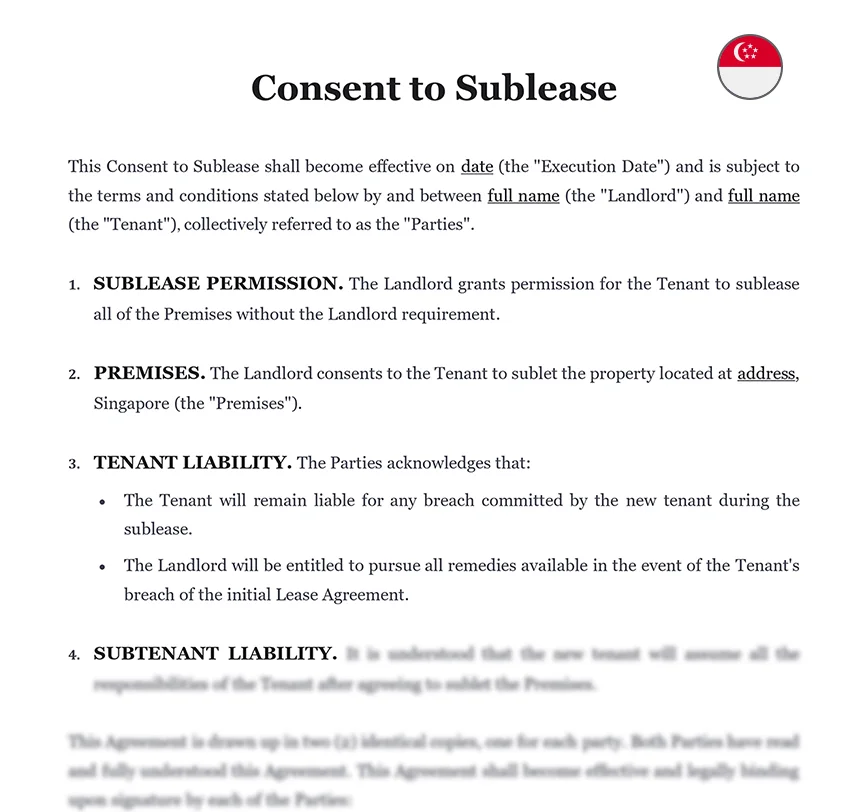Ready to use legal template
Drafted by experienced lawyers
Compliant with Singapore law
Ready to use legal template
Drafted by lawyers
Compliant with Singapore law
Home › Rent your property › Consent to sublease
Learn more about Consent to Sublease Letter in Singapore
Under Singaporean law, a present renter can sublease his or her apartment via a Consent to Sublease paperwork. It takes the form of a formal agreement signed by the landlord and the tenant that authorizes the subletting for a period not to exceed the original Lease Agreement‘s lifespan. When a renter is gone for a period of time, subletting may be an option. It enables the tenant’s rent to be paid while he or she is away. It also permits a current renter to split the rent with someone with whom they want to share the flat for a short period of time. When signing the Sublease Agreement, the tenant must give a copy of the landlord’s written authorisation to the subtenant. A copy of the current master Lease Agreement must also be provided by the tenant.
Table of contents
What is a Consent to Sublease Letter?
There are a variety of reasons why you may need to sublease the home you are renting. With a Consent to Sublease, you may obtain approval from the landlord and assist protect yourself legally as a tenant if you desire to form a subletter.
If you’re a landlord, you may use a Consent to Sublease to legally document the new renting agreement, making it clear who is living in your home and who is responsible for paying the rent:
1. You want to sublease a room, complete property, or commercial space.
2. You’re a landlord interested in subleasing alternatives for your tenants.
3. You’re the one who wants to sublet property.
A Consent to Sublease ensures that the contents of a new sublease agreement are properly smoothed out and documented for everyone involved—the tenant, the subletter, and the landlord all benefit from it. Because many landlords do not allow subleasing, if you are the tenant, you should first check your agreement. Even if it is not permitted under the lease, you might check with your landlord to see if they are open to a sublet. Furthermore, as a landlord, subleasing helps ensure that rent payments are not interrupted if your present renter is unable to meet their commitments. With a Consent to Sublease, everyone can be on the same page, in writing, whether you’re the renter, landlord, or potential subletting tenant.
How does Consent to Sublease work in Singapore?
A sublease, also known as a sublet contract, allows an original tenant of a rental property to become a sublandlord and rent out a portion (or all) of the property to a new renter, known as the subtenant. The original tenant retains their obligations to the landlord in this agreement, as well as being liable for any damages or lease violations caused by the subtenant. The sublandlord often collects rent from the subtenant and transfers it to the landlord.
Sublease agreements are available from Themis Partner for both residential and business buildings.
A sublease agreement clarifies the obligations and expectations of all three parties involved in a sublet (the landlord, sublandlord, and subtenant). A sublease agreement can help you avoid future misunderstandings about payment specifics, maintenance tasks, and liabilities by planning ahead of time.
Common sections in Sublease Consents
The following is a list of frequent sections found in Consents to Sublease:
| ➤ Landlord's Consent |
| ➤ Landlord's Reimbursement |
| ➤ Tenant's Non-Release |
| ➤ Additional Transfers |
| ➤ Landlord's Relationship |
| ➤ General Provisions |




